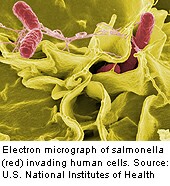- Skip Storing This Everyday Product in the Fridge Door
- Green Tea + B3 Pairing May Boost Brain Health
- Navigating Your Midlife Crisis: Embracing New Possibilities
- City Raccoons Showing Signs of Domestication
- Mapping the Exposome: Science Broadens Focus to Environmental Disease Triggers
- One Week Less on Social Media Linked to Better Mental Health
- Your Brain Changes in Stages as You Age, Study Finds
- Some Suicide Victims Show No Typical Warning Signs, Study Finds
- ByHeart Formula Faces Lawsuits After Babies Sickened With Botulism
- Switch to Vegan Diet Could Cut Your Greenhouse Gas Emissions in Half
Antibiotic Resistance Among Foodborne-Illness Germs a Mixed Bag: CDC


There’s good news and bad news about antibiotic resistance among the germs that cause foodborne illnesses, a new U.S. government report released Tuesday shows.
“Our latest data show some progress in reducing resistance among some germs that make people sick, but unfortunately we’re also seeing greater resistance in some pathogens, like certain types of salmonella,” Dr. Robert Tauxe, deputy director of the division of foodborne, waterborne and environmental diseases at the U.S. Centers for Disease Control and Prevention, said in an agency news release.
Each year, antibiotic-resistant infections from foodborne germs cause about 430,000 illnesses in the United States, according to the CDC.
The agency’s latest data, from 2012, show that multidrug-resistant salmonella, which causes about 100,000 illnesses a year, decreased during the past 10 years and resistance to two important types of antibiotics — cephalosporins and fluoroquinolones — remained low.
However, the rate of resistance to quinolone drugs in Salmonella typhi — which causes typhoid fever — rose to 68 percent in 2012. This means that this class of drugs, one of the most common treatments for typhoid fever, may no longer be effective.
The CDC also said that about 20 percent of Salmonella Heidelberg infections were resistant to the cephalosporin drug ceftriaxone. S. Heidelberg has been linked to recent outbreaks of illness associated with poultry.
Ceftriaxone resistance makes severe salmonella infections harder to treat, especially in children, the CDC noted.
Among the other findings:
- Campylobacter resistance to the antibiotic ciprofloxacin remained at 25 percent, despite a 2005 ban on the use of the antibiotic enrofloxacin in poultry. Ciprofloxacin and enrofloxacin are both fluoroquinolone antibiotics.
- Shigella resistance to ciprofloxacin (2 percent) and azithromycin (4 percent) increased, but no strains were resistant to both drugs.
Resistance to fluoroquinolones remained low. However, 50 percent of infections resistant to the fluoroquinolone drug nalidixic acid were caused by Salmonella enteritidis, the most common salmonella type.
Resistance to nalidixic acid — used in laboratory testing for resistance — is related to decreased susceptibility to a widely used fluoroquinolone drug ciprofloxacin, the CDC said in its release.
Many of the nalidixic acid-resistant Salmonella enteritidis infections among Americans are acquired when they travel to other countries.
More information
The U.S. National Library of Medicine has more about foodborne illness.
Source: HealthDay
Copyright © 2025 HealthDay. All rights reserved.










